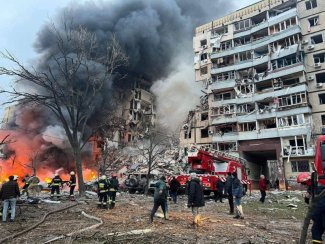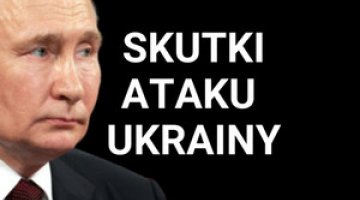Stalemate on the Zaporizhzhia front. Day 593 of the war

Heavy fighting continues on the Zaporizhzhia front, especially in the area of the Ukrainian wedge driven into the positions of the Russian Zaporizhzhia Army Group on the Kopani-Robotyne-Novoprokopivka-Verbove line. The Ukrainians have succeeded in repelling a number of Russian counterattacks on their flanks in recent days, conducted mainly by the forces of the 7th and 76th air assault divisions, but this has had meant they have halted their assault operations on the main attack directions (Novoprokopivka village, the hills to the east of it and the area around the village of Verbove). In order to secure their flanks, the Ukrainians also began attacking Russian positions in the area of Kopani village, but they had little success there (in previous months they did not carry out an assault on this part of the enemy’s fortified positions). The increased activity of the Russians on the neighbouring sections of the Zaporizhzhia front should be noted; in places they managed to launch counterattacks and achieve local tactical successes (they seized several Ukrainian positions near Marfopil and Pryiutne, among others). This localised taking of the initiative by Russia may be related to the regrouping of Ukrainian forces and the transfer of some of the brigades previously fighting here to the rear or other sections of the front. The Russian media suggests that Ukrainian naval infantry brigades active in previous months south of Velyka Novosilka have been redeployed to the Nova Kakhovka and Kherson areas, where they are allegedly preparing for a landing operation on the left bank of the Dnieper.
On the Donbas front, the Ukrainians are continuing their offensive south of Bakhmut, where they had previously gained bridgeheads on the eastern side of the Bakhmut-Horlivka railway line and are now trying to reach the road connecting the two cities. They are also attacking Kurdiumivka, which is still mostly in enemy hands. Assault operations here are met with a robust defence and counter-attacks. The Russians, on the other hand, maintain the initiative in the Avdiivka and Marinka areas, as well as on the frontline on the border between the Kharkiv and Luhansk oblasts. There, they have stepped up offensive operations in recent days, especially in the Kupiansk and Makiivka areas (about 20km south-east of Svatove), where they have had minor tactical successes. Their intensive use of armoured weapons in the area is noteworthy, including relatively modern T-90 tanks.
On the night of 6/7 October, the Russians attacked the Odesa oblast with Oniks anti-ship missiles, launched from Crimea using the Bastion system. According to a communiqué from the Operational Command “South”, the missiles hit a guesthouse and a grain elevator (according to Russian propaganda channels, the target of the strike was a guesthouse in Chornomorsk converted into a barracks). At dawn on 8 October, Russia attacked Kostiantynivka, probably with an Iskander ballistic missile. As reported by the Donetsk Regional Prosecutor’s Office, ten residential apartment blocks and a dozen houses were damaged and several people were injured. In turn, on the night of 9/10 October, the Russians attacked the south of Ukraine with 36 Shahed 136/131 drones. The Ukrainian Air Force Command claimed it shot down 27 of them; the remaining drones are believed to have hit unspecified infrastructure facilities. In addition, Russia has been continuously employing aviation, using guided bombs (typically 250 kg, 500 kg and 1,500 kg) to hit Ukrainian frontline facilities. The main targets of the bombing raids are the Orikhiv area and the Kherson oblast.
On 6 October, the German company Rheinmetall announced that it had concluded an executive contract worth more than €100 million for the supply of 155-mm artillery ammunition to the Armed Forces of Ukraine and Germany, and four days later announced that another contract had been concluded. Tens of thousands of artillery shells are to be delivered between 2023 and 2024. Thus, three executory contracts have already been signed for the July framework agreement for the supply of artillery ammunition to Germany and Ukraine between 2023 and 2029 – with a total value of €1.2 billion.
The Polish Ministry of Foreign Affairs has published a report outlining Poland’s arms and military equipment exports in 2022. Due to a secrecy clause, it does not include information on the arms and military equipment transferred by the Polish Army as free donations to Ukraine, listing only those items that Ukraine has already purchased and delivered. The list includes: 60 MTLB armoured personnel carriers, 19 Dzik II armoured cars, BRDM 2 reconnaissance vehicle, 70 2S1 Goździk self-propelled gun, 18 Krab self-propelled gun (out of 54 purchased in 2022), 89 mortars of 82-mm calibre, 4 BM-21 Grad multiple rocket launcher, 34 launch mechanisms for Piorun MANPADS (man-portable air-defense system) and 39,280 S-8 unguided rocket. In addition, Ukraine purchased and received 5,050 pistols, 387 carbines, 1,750 light machine guns, 5,520 underslung and slide-on grenade launchers, 4,911 anti-tank launchers and 274 mortars of less than 75-mm calibre.
On 10 October, President Volodymyr Zelensky signed an executive decree to the decision of the National Security and Defence Council of Ukraine to allocate more than 21% of GDP from the state budget to defence in 2024. At the same time, the government must provide funding for the needs of the security and defence sector in the amount of at least 1.69 trillion hryvnias (more than $46 billion). A day earlier, Zelensky appointed General Anatoliy Barhylevych as the new commander of the Territorial Defence Forces of the Ukrainian Armed Forces. He had been Chief of Staff of the Eastern Group of the Armed Forces since 2022 and previously Deputy Commander of the Land Forces. He distinguished himself in the defence of Kyiv and the Kharkiv oblast offensive last year.
On 8 October, Ukrainian Air Force spokesman Yuriy Ihnat indicated that Russia was increasing the production of attack drones. He added that this is impossible without Iranian support. According to Ihnat, during the winter, Ukraine’s air defence will focus on covering energy facilities, strategic state facilities and critical infrastructure. He mentioned that Ukraine still lacks adequate defence systems. He called on local administrations to support the creation of mobile air defence groups specialising in destroying drones, including through the purchase of searchlights, thermal imaging equipment or all-terrain vehicles.
On 7 October, the head of the press centre of the Operational Command ‘South’, Nataliya Gumenyuk, conveyed that, since the beginning of the aggression, the Russians have deployed around 450 mines in the economic zone and territorial waters of Ukraine. She added that 30 mines of various types had been neutralised this year.
On 10 October, Ukrainian military intelligence warned that the Russian army had handed over weapons captured in Ukraine and produced in the US and EU countries to Hamas terrorists. This is to be used in a disinformation campaign accusing Kyiv of allegedly regularly selling Western weapons to terrorists. This is intended by the Kremlin to influence the reduction of Western military aid to Ukraine.
On 8 October, the Center for Strategic and International Studies (CSIS) published material in which it posted satellite images of the railway border crossing between Russia and North Korea. They show a sharp increase in freight shipments. According to US analysts, this could indicate the supply of ammunition and military equipment to the Russian army in exchange for, among other things, food aid. In mid-September, Kim Jong Un discussed military cooperation with Vladimir Putin during a visit to the Far East.
On 6 October, the Russian government approved “for security reasons” a special entry procedure for Ukrainian citizens. From 16 October, they will only be able to enter Russia through the Vientuļi-Ludonka road border crossing on the border with Latvia, and Moscow’s Sheremetyevo airport. The restrictions do not apply to Ukrainians travelling from the occupied Donetsk, Luhansk, Zaporizhzhia and Kherson oblasts.
Commentary
At the end of August, Russia – then in a difficult situation after the successful Ukrainian attacks in the Robotyne and Verbove areas – concentrated two air assault divisions (the 7th and 76th), drawn from other sections of the front, on the wings of the enemy grouping. Their task was to stabilise the Russian defensive line in the first instance and, in the second, to launch strikes on the starting base of the Ukrainian advance (Novodanylivka-Mala Tokmachka-Bilohirya area). The first of these objectives was achieved at the cost of significant losses in the ranks of these units – the Ukrainian advance was halted, especially in the section east of Novoprokopivka (their assault groups were stuck there in the foreground of the prevailing line of hills above the area). In contrast, the Russians failed to develop a strike and push the enemy out of the area they had occupied in the summer. It seems that their main objective for the coming weeks will be to maintain the fortified positions in the Kopani-Novoprokopivka-Verbove area at all costs. Because of the terrain, these allow them to have fire control over the area from which the Ukrainian assaults are coming.





